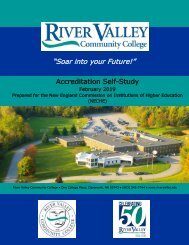You also want an ePaper? Increase the reach of your titles
YUMPU automatically turns print PDFs into web optimized ePapers that Google loves.
to ensure students were provided study guides and homework assignments. Following<br />
these changes, exam scores increased and fell more in line with the other course sections.<br />
Another way in which these common assignments in A&P I and A&P II has been useful in<br />
assessing outcomes is by providing a way for the Program Director to recognize gaps in<br />
student knowledge. On the final case studies there is a set of expected answers. If there<br />
is an answer to a question that varies considerably from the expectations of the<br />
instructors, it provides a clue that there is a gap in teaching of particular content. In A&P<br />
II, reviewing problem areas on exams has led to improvements in teaching of specific<br />
concepts (blood typing and transfusions) as well as improving the way in which A&P I and<br />
A&P II concepts are related including: greater emphasis on second messenger systems<br />
and organic compounds; greater emphasis on cell respiration and organelle function;<br />
greater emphasis on hormones, and greater emphasis on adrenergic receptors and effects.<br />
The most widespread data collection that shows course outcomes are reflected in the data<br />
collected as part of the Math Co-Requisite Project described in Standard Five. Prior to<br />
implementation of the Co-Requisite Project, students in developmental math courses had<br />
only a 21% likelihood of passing a college-level mathematics course within two years. The<br />
pass rate for Spring 2018 was 94%. These results are significantly higher than the pass<br />
rates for students who begin in developmental mathematics, and are at or above the pass<br />
rates of students who meet the prerequisites for college-level mathematics.<br />
Most of the Allied Health programs including Nursing, as well as the Early Childhood<br />
Education and Social Science programs, have additional assessments of job readiness by<br />
requiring their students to participate in off-campus learning experiences. These clinical<br />
rotations, affiliations, practicums, internships and fieldworks provide direct, hands-on<br />
learning in the field of study. These courses are assessed through multiple avenues which<br />
include both direct observation of the student by <strong>RVCC</strong> faculty as well as via informal<br />
(phone or in-person conversations) and formal (completion of provided grading rubrics)<br />
assessments by the non-faculty professionals in the field who are hosting and supervising<br />
the <strong>RVCC</strong> students. Data related to outcome measures for these experiences is kept by<br />
each Clinical Coordinator or Program Director. For example, the Physical Therapist<br />
Director of Clinical Education provides a summation of the outcomes of the assessment<br />
tool completed by the Clinical Preceptors working with <strong>RVCC</strong> students to the other faculty<br />
in the PTA program upon completion of the clinical courses. For the Spring of 2018 cohort<br />
(senior level clinical affiliation), the expectation at the end is that the students are rated at<br />
“entry-level” meaning they are considered by their preceptor to be ready to step into clinic<br />
work with only minimal supervision. The DCE provided the following summation of student<br />
assessment: “All students were rated as entry level by their clinical instructor after their<br />
clinical affiliation. The number of patients seen varied greatly between settings and<br />
individual clinics. Some students saw a maximum of 5 patients a day and some saw 10.<br />
The complexity of the patients varied greatly among the settings as well. Overall, the<br />
clinicians supervising the students agree that they are entry level PTAs after their senior<br />
affiliation.”<br />
Many of the Allied Health programs have student learning outcomes related to professional<br />
behaviors. Professionalism in the Allied Health fields has been an area highlighted by<br />
advisory committees in recent years, and in response, programs have implemented course<br />
objectives or program objectives which are reflective of professional behaviors expected in<br />
125 | P a g e





